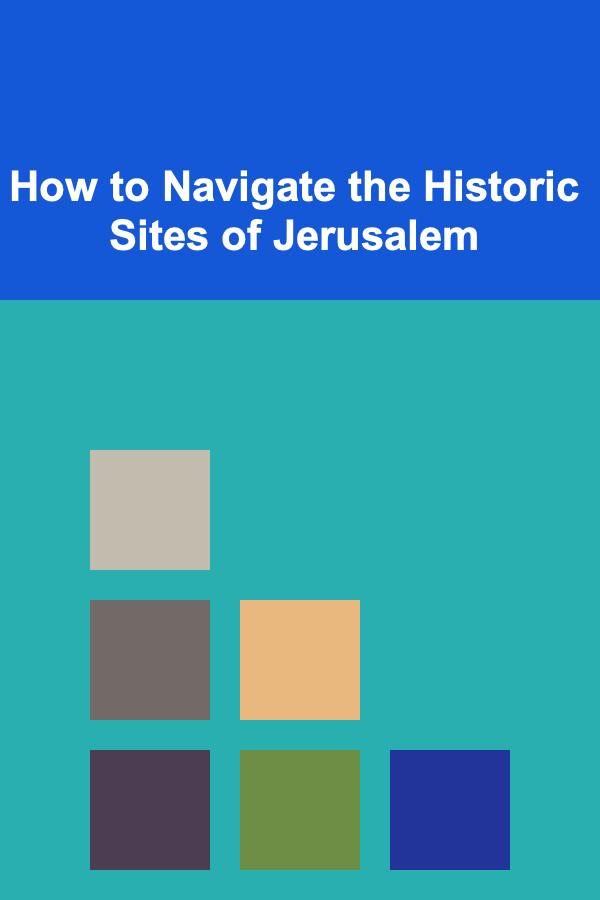
How to Navigate the Historic Sites of Jerusalem
ebook include PDF & Audio bundle (Micro Guide)
$12.99$11.99
Limited Time Offer! Order within the next:

Jerusalem is one of the most historically significant cities in the world. A place of religious importance for Judaism, Christianity, and Islam, its streets are steeped in millennia of history. The city is a maze of ancient stone walls, sacred sites, bustling bazaars, and timeless architecture. For any visitor, navigating its historic sites can be both a spiritual pilgrimage and an immersive journey into the past.
This guide will help you explore Jerusalem's most iconic historical landmarks, from the Western Wall to the Church of the Holy Sepulchre, offering practical tips for navigating the city's rich history and unique layout. Whether you're a first-time visitor or a seasoned traveler, understanding the city's topography, history, and culture will enhance your experience.
Understanding Jerusalem's Complex History
Jerusalem's history spans over 3,000 years, making it one of the oldest cities in the world. For many, visiting Jerusalem is a spiritual journey, as it is the birthplace of key religious figures and the location of pivotal events in the Bible, the Quran, and Jewish texts.
The Three Major Religions
- Judaism: Jerusalem is the site of the First and Second Temples, central to Jewish faith. The Western Wall, or Wailing Wall, is the last remaining part of the Second Temple, making it a deeply sacred place for Jews.
- Christianity: The city is central to the life of Jesus Christ. Key locations like the Church of the Holy Sepulchre, believed to be the site of Jesus' crucifixion, burial, and resurrection, are important pilgrimage sites for Christians.
- Islam: The Al-Aqsa Mosque and the Dome of the Rock are among the most sacred sites in Islam. The city is home to the Prophet Muhammad's night journey, where he ascended to heaven according to Islamic tradition.
The city's significance across these three religions has shaped its unique architecture, culture, and even its political landscape. The religious and historical complexity makes Jerusalem a fascinating city to explore.
Preparing for Your Visit
Navigating Jerusalem requires some careful planning, as the city's diverse and sometimes tense political and cultural dynamics can impact your visit. Here are some essential tips:
Safety and Respect
- Respect Local Customs: Jerusalem is a city that attracts people from all over the world, including many religious pilgrims. Dress modestly, especially when visiting religious sites.
- Security: Security checks are common, especially around the Old City and religious sites. Be prepared for bag searches and other security measures.
- Guides and Tours: To truly appreciate the depth of the city's history and religious significance, consider hiring a local guide. Their knowledge of the city's complex history can provide context to the sights you'll encounter.
Transportation
Jerusalem's Old City is divided into four quarters: Jewish, Christian, Muslim, and Armenian. The narrow, winding streets can be difficult to navigate, and car access is limited. Walking is often the best option for exploring the city's key historical sites. Public transportation, including buses and the light rail, can take you to major points outside the Old City.
Key Historic Sites in Jerusalem
Now, let's dive into some of Jerusalem's most iconic historic sites, each with its own story to tell. While many are located within the Old City, several important sites are spread throughout the city.
The Western Wall (Kotel)
Arguably one of the most recognizable symbols of Jerusalem, the Western Wall is the last remaining part of the Second Temple, which was destroyed in 70 CE. For Jews, it is the holiest site of prayer. Visitors often leave written prayers in the cracks of the wall, a practice that has become symbolic of hope and faith.
- How to Visit: The Western Wall is open every day of the week, and there are separate areas for men and women. Arrive early to avoid the crowds, especially during religious holidays.
- Tips: When visiting, dress modestly, covering shoulders and knees. It's customary to cover your head, so bring a kippah (yarmulke) if you don't have one.
The Church of the Holy Sepulchre
Located in the Christian Quarter of the Old City, the Church of the Holy Sepulchre is one of Christianity's holiest sites. Tradition holds that it is the place where Jesus was crucified, buried, and resurrected. The church is shared by six Christian denominations, and its structure reflects a complex blend of architectural styles and religious influences.
- What to See: Key areas include the Stone of Anointing (where Jesus' body is believed to have been prepared for burial), the Chapel of the Crucifixion, and the Tomb of Jesus.
- How to Visit: The church is open to visitors throughout the day, though it can become crowded, especially during Christian religious holidays. Early morning visits can offer a more peaceful experience.
The Dome of the Rock
An iconic symbol of Jerusalem, the Dome of the Rock is one of the most beautiful and recognized buildings in the city. Located on the Temple Mount, the dome houses the Foundation Stone, which is significant in both Jewish and Islamic traditions.
- Significance in Islam: For Muslims, the Dome of the Rock is where the Prophet Muhammad is believed to have ascended to heaven during his Night Journey. The structure is not a mosque but a shrine.
- How to Visit: The Dome of the Rock is located within the larger Al-Aqsa Mosque compound, which is accessible to Muslim visitors. Non-Muslim visitors can visit the surrounding areas but may have limited access to the interior of the Dome itself.
- Tips: Dress modestly and be prepared for security checks. The Temple Mount is closed to non-Muslims on Fridays and during certain religious holidays.
The Al-Aqsa Mosque
Just south of the Dome of the Rock, the Al-Aqsa Mosque is one of Islam's holiest sites. It is a site of profound religious importance for Muslims and serves as a center of worship, study, and pilgrimage.
- Visiting the Mosque: Al-Aqsa is open to Muslims for prayer, but non-Muslim visitors can also visit the surrounding areas. Be mindful of prayer times and religious activities.
- Access: As with the Dome of the Rock, non-Muslim visitors can enter the compound at specific times, and they must follow strict guidelines. It is important to check current regulations before planning your visit.
The Tower of David Museum
For those interested in Jerusalem's extensive history, the Tower of David Museum offers a comprehensive look at the city's past. Located near the Jaffa Gate, the museum is housed within the ancient citadel and provides exhibits on Jerusalem's archaeological findings and its role throughout history.
- What to See: Exhibits span from the city's ancient past to its more recent history, with interactive displays and artifacts from different eras.
- How to Visit: The museum is open daily, with the opportunity to explore both the inside exhibits and the citadel's ramparts for panoramic views of the city.
The Mount of Olives
For a panoramic view of Jerusalem, head to the Mount of Olives. This hilltop is one of the most significant locations in Christianity, as it was the site of many events in the life of Jesus.
- What to See: The Mount of Olives is home to several important sites, including the Church of All Nations, the Garden of Gethsemane, and the Tomb of the Virgin Mary.
- How to Visit: The Mount of Olives is accessible by foot or by car. It's best to visit early in the morning or later in the evening to avoid the midday heat and crowds.
The City of David
One of the oldest parts of Jerusalem, the City of David is the archaeological heart of the city. This area predates the Old City and was the site of King David's Jerusalem in biblical times.
- What to See: Visitors can explore the ancient City of David through tunnels, water systems, and remains of ancient walls and structures. The Hezekiah Tunnel, an ancient water tunnel, is a popular attraction.
- How to Visit: The City of David offers guided tours and interactive exhibits that bring ancient history to life.
Exploring Jerusalem's Modern Aspects
While Jerusalem is renowned for its ancient and religious sites, it also has a vibrant modern side. Walking through Jerusalem offers visitors an opportunity to explore the bustling markets, vibrant street art, and contemporary culture.
- Mahane Yehuda Market: This bustling marketplace is a blend of old and new, with fresh produce, spices, and traditional foods sold alongside trendy cafes and restaurants.
- The Israel Museum: The museum houses an impressive collection of Israeli art, archaeology, and Judaica, including the Dead Sea Scrolls.
Tips for Navigating Jerusalem's Historic Sites
- Wear Comfortable Shoes: Jerusalem's Old City has cobblestone streets, steep hills, and uneven terrain. Be prepared to walk a lot and wear comfortable shoes.
- Stay Hydrated: Jerusalem can be very hot, especially in the summer months. Carry a water bottle and take breaks in shaded areas.
- Timing: Try to visit the key religious sites early in the day to avoid crowds and enjoy a more serene experience.
Conclusion
Jerusalem is a city where the ancient and the modern intertwine, and its historic sites reflect the many layers of history and faith that have shaped the city over the millennia. Whether you're visiting for spiritual reasons, historical exploration, or simply the beauty of the city itself, navigating Jerusalem requires patience, respect, and curiosity.
As you journey through the winding streets and across the sacred stones, remember that Jerusalem is not just a city---it's a living testament to human history, a place where the past and present meet in a mosaic of faith, culture, and shared experiences.
Reading More From Our Other Websites
- [Organization Tip 101] How to Plan for Holiday Jewelry Displays or Gifting
- [Organization Tip 101] How to Plan Activities for Guests During Your Wedding Weekend
- [Organization Tip 101] How to Plan Your Garden Layout for Maximum Efficiency
- [Home Family Activity 101] How to Plan a DIY Family Arts and Crafts Festival
- [Home Storage Solution 101] How to Store Seasonal Decorations Without the Clutter
- [Personal Care Tips 101] How to Care for Sensitive Skin: Personal Care Tips for Daily Use
- [Organization Tip 101] How to Use Technology to Remind You of Seasonal Tasks
- [Home Maintenance 101] How to Clean and Maintain Your Dishwasher for Longevity
- [Home Holiday Decoration 101] How to Incorporate Nature Into Your Holiday Home Decor
- [Personal Investment 101] Creating and Selling AI Solutions for Passive Income

How to Allocate Funds for Savings and Investments
Read More
How to Make Money Online as a Machine Learning Engineer: 10 Actionable Ideas
Read More
How to Maximize Savings: Taking Advantage of Educational Discounts
Read More
How to Optimize Under-Bed Storage for Extra Space
Read More
How to Set Up a Checklist for Effective Stakeholder Communication
Read More
How to Analyze Geopolitical Events and Their Effect on Global Markets
Read MoreOther Products

How to Allocate Funds for Savings and Investments
Read More
How to Make Money Online as a Machine Learning Engineer: 10 Actionable Ideas
Read More
How to Maximize Savings: Taking Advantage of Educational Discounts
Read More
How to Optimize Under-Bed Storage for Extra Space
Read More
How to Set Up a Checklist for Effective Stakeholder Communication
Read More